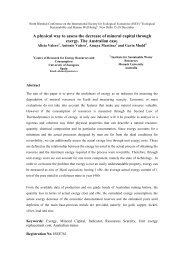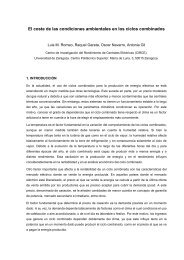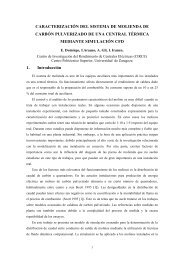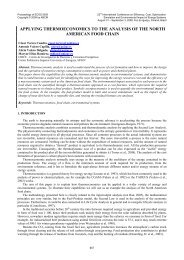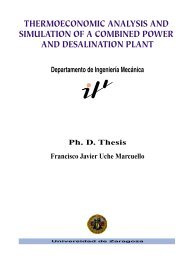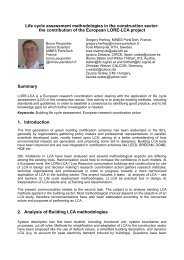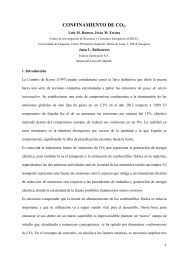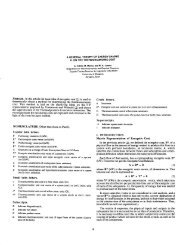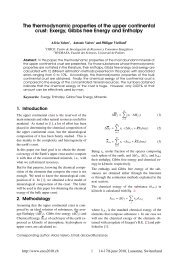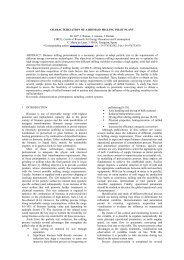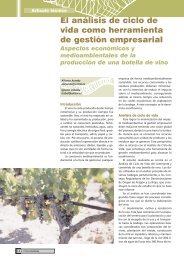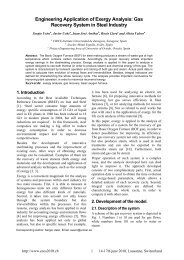Operational and Design Strategies to Improve PFBC Power ... - circe
Operational and Design Strategies to Improve PFBC Power ... - circe
Operational and Design Strategies to Improve PFBC Power ... - circe
Create successful ePaper yourself
Turn your PDF publications into a flip-book with our unique Google optimized e-Paper software.
<strong>Operational</strong> <strong>and</strong> <strong>Design</strong> <strong>Strategies</strong> <strong>to</strong><br />
<strong>Improve</strong> <strong>PFBC</strong> <strong>Power</strong> Plant Efficiency<br />
Luis M. Romeo & Cristóbal Cortés<br />
Centro de Investigación del Rendimien<strong>to</strong> de Centrales<br />
Eléctricas (CIRCE)<br />
Diego Martínez<br />
Escatrón <strong>PFBC</strong> <strong>Power</strong>plant<br />
ENDESA, S.A.
<strong>Operational</strong> <strong>and</strong> <strong>Design</strong> <strong>Strategies</strong> <strong>to</strong> <strong>Improve</strong> <strong>PFBC</strong> <strong>Power</strong> Plant<br />
Efficiency<br />
Luis M. Romeo <strong>and</strong> Cristóbal Cortés, CIRCE, Spain<br />
Diego Martínez, ENDESA, S.A., Spain<br />
Summary:<br />
This paper presents a semiempirical model of a pressurised fluidised bed combustion power plant. It is well-<br />
know that one of the options <strong>to</strong> retrofit existing steam plants is <strong>to</strong> build a <strong>PFBC</strong> power plant that take<br />
advantage of the existing steam turbine <strong>and</strong> increase the life of the power plant. The retrofit is based in the<br />
replacement of the conventional old boiler of pulverised fuel by a pressurised fluidised bed boiler. Also, a gas<br />
turbine is incorporated <strong>to</strong> the system. The steam generated drives the old turbine unit <strong>and</strong> the combustion<br />
gases drives the gas turbine. Both the original efficiency <strong>and</strong> the <strong>to</strong>tal load improve in the retrofit.<br />
The model has been developed <strong>to</strong> simulate <strong>and</strong> predict the Escatrón (Spain) <strong>PFBC</strong> power plant behaviour<br />
under different operating conditions. Good agreement has been found between the computed results <strong>and</strong><br />
actual plant data at different operational regimes for the most important variables of the power plant. The<br />
main aim of this model is <strong>to</strong> study different strategies <strong>to</strong> improve the efficiency in the power plant. This paper<br />
describes the model developed, the strategies <strong>to</strong> improve efficiency, as well as its results, <strong>and</strong> as<br />
conclusions, point out the improvements <strong>and</strong> perspectives for future work
1. Abstract<br />
Nowadays the state of the art of <strong>PFBC</strong> technology lies halfway between the demonstration stage in units of<br />
intermediate size (72-79 MWe) <strong>and</strong> the commercial availability of larger scale plants. The operation of<br />
existing power stations has demonstrated that several points remain widely open <strong>to</strong> improvements. Due <strong>to</strong><br />
fuel quality effects <strong>and</strong> the use of retrofitted plants, the <strong>PFBC</strong> power plant efficiency presently dem<strong>and</strong>s<br />
significant improvements. Likewise, the high energy efficiencies offered by the <strong>PFBC</strong> concept had not been<br />
completely demonstrated. To overcome these difficulties <strong>and</strong> further develop the technology a semiempirical<br />
model of a pressurised fluidised bed power plant has been developed. The model has been validated with<br />
actual plant data, being able <strong>to</strong> predict the Escatrón (Spain) <strong>PFBC</strong> power plant behaviour under different<br />
operating conditions. It has been widely tested <strong>to</strong> study not only the fluidised bed behaviour, but also the<br />
influence of fluidised bed variables in the rest of the power plant. Good agreement has been found between<br />
the computed results <strong>and</strong> actual plant data at different operational regimes for the most important variables<br />
of the power plant (i.e. in-bed temperature profiles, fuel feed rate, entrainment rate, heat exchangers <strong>and</strong><br />
heaters thermal behaviour, steam <strong>and</strong> gas mass flow rate, gas <strong>and</strong> steam turbine power <strong>and</strong> power plant<br />
efficiency). The main aim of this model is <strong>to</strong> study different strategies <strong>to</strong> improve the efficiency in the power<br />
plant. These strategies include: the improvement of sootblowing schedules of external heat exchangers; air<br />
preheating system optimisation; selection of operational set-points that bring the highest efficiency;<br />
evaluation of the efficiency improvements due <strong>to</strong> design changes (changes in retrofitted steam turbines <strong>and</strong><br />
heat exchangers, natural gas reburning, selection of different types of coal). This paper describes the model<br />
developed, the strategies <strong>to</strong> improve efficiency, as well as its results, <strong>and</strong> as conclusions, point out the<br />
improvements <strong>and</strong> perspectives for future work.<br />
2. Introduction<br />
Pressurised fluidised bed combustion (<strong>PFBC</strong>) is an emerging technology for electricity generation, now being<br />
implanted across Europe. Its main advantages are the capability of h<strong>and</strong>ling low rank fuels, an excellent<br />
environmental performance, a high energy efficiency <strong>and</strong> a moderate specific investment in comparison with<br />
other advanced coal combustion concepts. Presently, two coal <strong>PFBC</strong> power stations are operating in Europe<br />
(Escatrón, Spain <strong>and</strong> Vartan, Sweden), <strong>and</strong> one unit is under construction at Cottbus (Germany). Specific<br />
details on the concept, design <strong>and</strong> operating experience have been summarised by Menéndez et al (1987),<br />
Anderson <strong>and</strong> Jansson (1991), Alvarez Cuenca et al. (1995) <strong>and</strong> Botros (1995).<br />
The operation of existing power stations has demonstrated that several points remain widely open <strong>to</strong><br />
improvement. In this respect, the inherently complex behaviour of the fluidised bed is logically the main<br />
concern. Apart from erosion <strong>and</strong> fouling effects, experience with given coal types has revealed unexpected<br />
modifications of bed density <strong>and</strong> heat transfer potential, bed temperature unevenness <strong>and</strong> variations of<br />
sensibility <strong>to</strong> operating conditions. The consequences of strong changes in the coal supply or combined<br />
combustion with other fuels have not been experienced yet.<br />
The future role of <strong>PFBC</strong> power plants in the market of electricity generation will depend on their ability <strong>to</strong><br />
mach the required load easily <strong>and</strong> with high efficiency in a scenario of variable dem<strong>and</strong> <strong>and</strong> high<br />
competitiveness. Therefore, one of the keys of the <strong>PFBC</strong> technology is <strong>to</strong> predict <strong>and</strong> <strong>to</strong> control how
proposed changes in process variables, in the power plant design or in the selection of fuels, would affect<br />
the performance <strong>and</strong> efficiency of the overall power plant.<br />
Unfortunately, the modelling of pressurised fluidised bed combus<strong>to</strong>rs has achieved up <strong>to</strong> now only a limited<br />
success. As a consequence, fluidised bed models of practical application are based on experiment. The high<br />
dem<strong>and</strong> of empirical information has been traditionally satisfied by means of experimental, small scale<br />
facilities. Among the great variety of reported studies, the papers of Chen <strong>and</strong> Saxena (1977), Chakraborty<br />
<strong>and</strong> Howard (1981), Selçuk <strong>and</strong> Ozkan (1984), Horio et al. (1985), Azevedo et al. (1989) <strong>and</strong> Bellgardt et al.<br />
(1987) are excellent contributions in the field of atmospheric fluidised bed combustion. Pressurised<br />
labora<strong>to</strong>ry beds have been used by Rajan <strong>and</strong> Wen (1980), Saxena (1988) <strong>and</strong> Mingyao et al. (1987),<br />
references which constitute the basic wealth of fundamental data specifically concerning <strong>PFBC</strong> technology.<br />
The empirical character of these developments raises logically the question of the actual applicability of the<br />
results <strong>and</strong> correlations <strong>to</strong> full scale equipment. Based on Grimethorpe <strong>PFBC</strong> experimental facilities, Hoy et<br />
al. (1987) have found a diagram for gas <strong>and</strong> steam turbine loads as a function of several process variables<br />
(bed height, bed temperature <strong>and</strong> air by-pass). They also concluded that a detailed analysis of part-load<br />
characteristic con be made only for a particular plant. This paper present the analysis <strong>and</strong> results for a large<br />
scale plant, the 80 Mwe Escatrón power station in Zaragoza (Spain).<br />
This paper presents the results of an comprehensive survey of empirical correlations, most of them one-<br />
dimensional, applicable <strong>to</strong> <strong>PFBC</strong>. The model is adjusted in order <strong>to</strong> reproduce process <strong>and</strong> in-bed data taken<br />
at Escatrón <strong>PFBC</strong> power station (Spain) under a wide range of operating conditions. This represents the<br />
novelty of using full scale information <strong>to</strong> validate empirical correlations, the objective being <strong>to</strong> draw specific<br />
conclusions on the reliability of empirical <strong>PFBC</strong> modelling. As we will discuss in detail, the overall agreement<br />
is good <strong>and</strong> the limitations can be adequately identified.<br />
3. Model Description<br />
In order <strong>to</strong> have a realistic power plant simulation, the input variables have been chosen <strong>to</strong> be the ambient<br />
conditions, the characteristic of the fuel, the main control set-points <strong>and</strong> the cycles deterioration of equipment<br />
performance (i.e. fouling in heat exchangers). The model is composed of three modules, describing steam<br />
<strong>and</strong> gas turbines <strong>and</strong> the pressurised fluidised bed.<br />
3.1 STEAM CYCLE.<br />
The simulation <strong>and</strong> behaviour of steam cycles is a well-know subject, having been previously studied in<br />
detail (S<strong>to</strong>dola <strong>and</strong> Loewenstein, 1945; Spencer et al., 1963). However, the cycle arrangement in a <strong>PFBC</strong><br />
power plant possesses special features dem<strong>and</strong>ing a particular treatment. For the heat-exchangers, a<br />
st<strong>and</strong>ard simulation have been chosen, taking in<strong>to</strong> account the fouling thermal resistance in condenser<br />
(cooled by water from a river) an economiser (fouled by flying ash). Fouling is considered as an external<br />
input, due <strong>to</strong> the difficulty in its accurate prediction.<br />
In the steam turbine, stage temperatures <strong>and</strong> pressures are calculated as linear function of the main steam<br />
flow rate; the flow rate <strong>to</strong> the heaters are calculated with the steam turbine flow coefficients (Cot<strong>to</strong>n <strong>and</strong>
Schofield, 1971; Cooke, 1985). Figure 1 compares measured <strong>and</strong> calculated steam turbine loads. Negligible<br />
deviations are observed with maximum differences of 1% for the whole operating range.<br />
3.2. GAS CYCLE.<br />
Concerning the gas turbine, a common characteristic of many component-based simulation studies is the<br />
lack of information about the component maps. Consequently, techniques have been proposed <strong>to</strong> overcome<br />
this difficulty (Saravanamut<strong>to</strong> <strong>and</strong> McIsaac, 1983). In this work, the simulation is based on experimental data<br />
correlated thought dimensionless numbers (Shepherd, 1956). In spite of the difficulties in modelling gas<br />
turbines, the results show good agreement. The gas cycle is composed by a two-spool gas turbine with the<br />
high-pressure turbine connected <strong>to</strong> the high pressure compressor <strong>and</strong> the alterna<strong>to</strong>r. In addition <strong>to</strong> the<br />
general lack of design information (non-availability of gas turbine characteristics) with the <strong>PFBC</strong> lay-out,<br />
simulation is even more involved. For these reasons, the use of well-know methods (Cohen et al, 1983;<br />
Bathie, 1983) are unsuitable. One of the best solution is <strong>to</strong> combine dimensional analysis with experimental<br />
data. Dimensionless analysis has been previously used <strong>to</strong> build universal compressor characteristics<br />
(Saravanamut<strong>to</strong>o <strong>and</strong> MacIsaac, 1983; Muir et al., 1983). The theoretical basis of dimensional analysis for<br />
gas turbines is well-know (Shepherd, 1956), although some modifications have been made in this case. The<br />
fouling of the low-pressure compressor (LPC) makes their coefficients decrease with time. Since the fouling<br />
evolution is complex, it has been taken as an external output modifying the corresponding compressor<br />
characteristic. Moreover the control by variable guide vanes makes the turbine coefficients inappropriately<br />
variable under constant operating conditions. A new <strong>and</strong> more stable coefficient has been found <strong>and</strong> is used<br />
<strong>to</strong> calculate the gas output temperature (Romeo et al., 1997). A comparison between the measured <strong>and</strong><br />
calculated gas output temperature is show in figure 2. Small differences of 5 ºC are observed.<br />
3.3. PRESSURISED FLUIDISED BED COMBUSTOR.<br />
The simulation of the pressurised fluidised bed combus<strong>to</strong>r is based on a previous work (Romeo et al., 1994)<br />
but some modifications have been made <strong>to</strong> enlarge the operational load range simulated <strong>and</strong> <strong>to</strong> take in<strong>to</strong><br />
account a bed height larger than design. The model is composed of five submodels describing fluid<br />
dynamics, elutriation, sulphur retention, coal combustion (char <strong>and</strong> volatile matter) <strong>and</strong> heat transfer. One-<br />
dimensional behaviour is assumed, i.e. all the predicted values are interpreted as the average of different<br />
heights. The combus<strong>to</strong>r has been divided in six cells. Five of them model the bed <strong>and</strong> the last represent the<br />
freeboard zone. This scheme result from an equilibrium between accuracy, data available <strong>to</strong> validate the<br />
results at different heights, <strong>and</strong> calculation time. The division also reflects the differences in density of steam<br />
tubes along the bed.<br />
Fluid dynamics is evaluated with correlations taken from different contributions. Minimum fluidisation velocity<br />
is evaluated after Chitester et al. (1984); bubble diameter as the average of Dar<strong>to</strong>n et al. (1977) <strong>and</strong> Rowe<br />
(1976) correlations; bubble velocity is evaluated with the equation of Kunni <strong>and</strong> Levenspiel (1977); finally the<br />
bubble <strong>and</strong> void fraction is calculated according with Kunni <strong>and</strong> Levenspiel (1990). Average bed <strong>and</strong> single<br />
cell density are calculated using the estimated void fraction <strong>and</strong> the average particle density.<br />
Char combustion is evaluated as the oxidation of carbon, whereas the combustion of volatile is calculated by<br />
subtracting the char energy content from the coal heating value. Given the data available on Escatrón coals,
this is the only option in our case, if only a first approximation <strong>to</strong> the physical reality, <strong>and</strong> has been used<br />
previously under the same circumstances of lack of experimental data (Hyppänen et al, 1991). Since char<br />
combustion can be considered <strong>to</strong> be uniform, the evolution of volatile matter becomes a controlling fac<strong>to</strong>r,<br />
specially when firing low rank coals. A special treatment has been given <strong>to</strong> this question, having developed a<br />
new scheme for the spatial calculation of the heat release (Romeo et al., 1997)<br />
Heat transfer from the fluidised bed <strong>to</strong> the surface of internals is due <strong>to</strong> three contributions: particle<br />
conduction, gas convection <strong>and</strong> thermal radiation. Particle conduction is commonly divided in<strong>to</strong> two different<br />
contributions, which are the limits of the correlation formulae for “small” <strong>and</strong> “large” particles (Botterill, 1989).<br />
In fluidised beds with small particles (up <strong>to</strong> approx. 800 µm), this is the main contribution, whereas gas<br />
convection dominates with large particles <strong>and</strong> in pressurised beds. The Chekansky correlation (Botterill,<br />
1989), is adopted for conduction mechanisms due <strong>to</strong> small particles. The contribution of large particles is<br />
calculated with the correlation of Denloye <strong>and</strong> Botterill (1978), tested under pressures up <strong>to</strong> 10 bar. Gas<br />
convection heat transfer is calculated by the Nusselt type equation of Baskakov et al. (1973) which has been<br />
widely tested (George <strong>and</strong> Welty, 1984; Gomar <strong>and</strong> Renz, 1991). Radiation in fluidised beds begins <strong>to</strong> be<br />
significant at approximately 600 °C <strong>and</strong> its effect increases with particle size <strong>and</strong> decreases with tube pitch.<br />
The radiation heat transfer coefficient is evaluated with the effective emissivity ε e of Baskakov et al. (1973).<br />
In accordance with this use of heat transfer correlations, overall heat transfer coefficients are estimated as<br />
the sum of the three contributions. Since the area of non-immersed tubes is small for the operating<br />
conditions of the Escatrón bed, freeboard heat transfer is calculated as the result of gas convection <strong>and</strong><br />
thermal radiation, neglecting the contribution of entrained particles (Clark et al, 1989; Golan et al, 1980).<br />
Figure 3 shows a comparison between the steam mass flow rate data <strong>and</strong> the computed results. With a wide<br />
range of operating conditions (75-95% maximum load), only small deviations, about 4% of the value, are<br />
observed. Fig. 4 shows the results for the average bed density, also exhibiting the same level of agreement<br />
for a large variation of this variable. The integrated model consists in the coupling of the three modules<br />
above described, intended <strong>to</strong> predict the most important plant variables. The simulation exhibits a good<br />
agreement with experimental data. As an example, figure 5 shows a comparison between computed results<br />
<strong>and</strong> measurements for the overall plant load in performance test. Although, in two cases, deviations are<br />
around 3 MW, in most cases deviations up <strong>to</strong> 2 MW are observed <strong>and</strong> can be reasonably accepted in such a<br />
wide operational range.<br />
4. <strong>Strategies</strong> <strong>to</strong> <strong>Improve</strong> Efficiency.<br />
The practical importance of the model stems from it uses as a <strong>to</strong>ol in evaluating design <strong>and</strong> operational<br />
changes. Many details of the <strong>PFBC</strong> plant technology still dem<strong>and</strong> a dedicated study, specially those that<br />
concerns the efficiency <strong>and</strong> availability improvements. The following list gives some examples of studies that<br />
have been or are being undertaken with the aid of the plant simula<strong>to</strong>r:<br />
(i) Optimisation of the on-load cleaning schedule of the economiser, which affects plant efficiency<br />
<strong>and</strong> steam turbine load.<br />
turbine load.<br />
(ii) Possibility of increasing cyclone cooling, quantification of their influence in reduction of gas
(iii) Reutilization of a low-pressure heater, in order <strong>to</strong> improve steam cycle efficiency<br />
(iv) Evaluation of plant performance <strong>and</strong> efficiency at partial load operation<br />
4.1. ECONOMISER<br />
Depending on the ash <strong>and</strong> sulphur content of the coal <strong>and</strong> the behaviour of the cyclones, small particles (<<br />
10 μm) are no collected by cyclones <strong>and</strong>, after passing thought the gas turbine are slowing down at the<br />
economiser, where are stuck between the fins of the heat exchanger tubes. These ashes need <strong>to</strong> be<br />
removed <strong>and</strong> cleaned from the economiser by means of an on-load cleaning schedule due <strong>to</strong> the heat<br />
transfer from hot gases <strong>to</strong> water decrease with economiser fouling. The simulation has allowed <strong>to</strong> optimise<br />
the cleaning schedule <strong>and</strong> <strong>to</strong> quantify the improvements in both, load <strong>and</strong> power plant efficiency.<br />
The most important conclusions of a detailed study show that a non-effective cleaning may means important<br />
losses of load <strong>and</strong> efficiency. A long or inefficient on-load cleaning schedules or even the non-cleaning<br />
suppose a lost up <strong>to</strong> 0.9 % in efficiency <strong>and</strong> 1.4 MW in the steam turbine due <strong>to</strong> a increase in gases<br />
temperature of 50 ºC in chimney, table 1.<br />
UA (kW/ºC) Steam Turbine<br />
<strong>Power</strong> (MW)<br />
Gases Temp.<br />
Chimney (ºC)<br />
<strong>Power</strong> Plant<br />
Efficiency (%)<br />
Clean Economiser 340 63.0 196.0 34.12<br />
Foul Economiser 140 61.6 245.5 33.20<br />
Table 1. Comparison between the power plant behaviour with a clean or foul economiser. Simulation results.<br />
For this reason a detailed analysis of the economiser <strong>and</strong> the sootblowing design are needed <strong>to</strong> take<br />
advantage of the hot flue gases from the gas turbine (400 ºC). The economiser must be carefully designed <strong>to</strong><br />
be capable of reducing the gas temperature up <strong>to</strong> 170 ºC or near the acid point of the gases <strong>and</strong> be easily<br />
cleaned by compressed air of steam. That means not <strong>to</strong> have fins or at least, not very close each other <strong>to</strong><br />
minimise the ash stuck between them which reduce the efficiency <strong>and</strong> the power produced by the steam<br />
turbine. The lost of efficiency due <strong>to</strong> a “bad” design join with a inefficient on-load cleaning schedule is around<br />
1.1% in power plant efficiency <strong>and</strong> 1.6 MW, table 2.<br />
UA (kW/ºC) Steam Turbine<br />
<strong>Power</strong> (MW)<br />
Gases Temp.<br />
Chimney (ºC)<br />
<strong>Power</strong> Plant<br />
Efficiency (%)<br />
Clean Economiser 500 63.3 185.0 34.32<br />
Foul Economiser 140 61.6 245.5 33.20<br />
Table 2. Comparison between the power plant behaviour with a clean <strong>and</strong> good designed <strong>and</strong> a foul <strong>and</strong> bad designed<br />
4.2. CYCLONE COOLING<br />
economiser. Simulation results.<br />
Another study that has been undertaken with the simulatior is the possibility of increasing cyclone cooling in<br />
order <strong>to</strong> reduce cyclone ash sintering <strong>and</strong> its associated plant unavailability. The temperature has a<br />
important influence in the sintering of the ash in cyclones so, a decrease in temperature is believed <strong>to</strong> reduce
the possibility of sintering formation in cyclones, that means a reduction of problems of unavailability.<br />
Important aspects are the quantification of the subsequent reduction in gas turbine load <strong>and</strong> efficiency of the<br />
plant. Depending of the temperature reduction by cyclone cooling the lost in gas turbine load is around 0.6<br />
MW each 10 ºC of temperature reduction. The efficiency decrease is approximately 0.15 % with the same<br />
temperature reduction. The reduction in unavailability can not be estimated, although is clear that a bigger<br />
temperature reduction a bigger availability obtained. A reduction of 10 – 20 ºC is believed <strong>to</strong> be enough <strong>to</strong><br />
notice the effects in sintering reduction, but in this case a practical study should be needed <strong>to</strong> take any<br />
conclusion.<br />
4.3. OPERATING PARAMETERS<br />
Partial load <strong>and</strong> changes in operating conditions have also influence in efficiency. There are some variables<br />
<strong>to</strong> match a required load: mean bed temperature <strong>and</strong> bed height can be modified, <strong>and</strong> also the air flow from<br />
the gas turbine compressor. In the particular case of <strong>PFBC</strong> mean bed temperature changes have more<br />
influence that bed height or air flow changes, both in efficiency <strong>and</strong> load. Approximately, in the whole<br />
operating range a variation of 10 ºC in the mean bed temperature means a variation of 1.8 MW in load (1.1<br />
MW in the steam turbine <strong>and</strong> 0.7 MW in gas turbine). The efficiency changes are from 0.16 up <strong>to</strong> 0.2 % with<br />
the same temperature variation, with more influence at reduced loads, table 3. Changes in bed height has a<br />
smaller influence in load, 0.7 MW each 10 cm of height changes up <strong>to</strong> a bed height of 3.5 m., <strong>and</strong> above the<br />
tube bundle (3.55 m) just 0.3 MW with the same height variation. Variations in efficiency are also smaller.<br />
Mean Fluidised<br />
Bed Temp (ºC)<br />
Steam Turbine<br />
<strong>Power</strong> (MW)<br />
Steam Turbine<br />
<strong>Power</strong> (MW)<br />
Steam Turbine<br />
<strong>Power</strong> (MW)<br />
<strong>Power</strong> Plant<br />
Efficiency (%)<br />
825 58.1 11.9 70.0 33.37<br />
835 59.2 12.6 71.8 33.57<br />
845 60.4 13.2 73.6 33.75<br />
855 61.5 13.8 75.3 33.91<br />
Table 3. Influence of the mean bed temperature in the behaviour of the <strong>PFBC</strong> power plant. Simulation results.<br />
With the help of the model an important conclusion has been addressed respecting the air flow rate. The<br />
best operating strategy <strong>to</strong> reduce losses of efficiency is <strong>to</strong> use the minimum air needed for a uniform <strong>and</strong><br />
complete coal combustion (around 2.0 – 2.5 % oxygen content in the gases <strong>to</strong> gas turbine). In spite of it is<br />
believed that an increase in air flow rate would improve gas turbine load <strong>and</strong> power plant efficiency due <strong>to</strong> an<br />
increase in gas flow <strong>to</strong> gas turbine, the results of the simula<strong>to</strong>r conclude the opposite. An increase of 2.0 kg/s<br />
of air compressed has not a effect in the power plant load, just a small increase in steam turbine <strong>and</strong> a<br />
decrease in gas turbine, with a efficiency reduction of 0.2 %. This is because the power needed <strong>to</strong> compress<br />
air depends on the r.p.m. of the gas turbine compressor <strong>to</strong> the power of three, while the power produced in<br />
the gas turbine is linear with the gases flow. Moreover, if the control variables of the pressurised fluidised<br />
bed remains constant, a bigger air flow means a lower gases temperature, which influences <strong>to</strong> the gas<br />
turbine <strong>to</strong> reduce load. So, it is concluded that a variation in air flow must be followed by a variation (in the<br />
same direction) of the fluidised bed control variables.
Conclusions<br />
The overall simulation of a <strong>PFBC</strong> power plant has been developed. The model is capable <strong>to</strong> predict the most<br />
important variables of the power plant, i.e. bed temperature profiles, steam <strong>and</strong> mass flow rate, steam <strong>and</strong><br />
gas turbine power, power plant efficiency. All of them have been compared with experimental data under<br />
different operational conditions <strong>and</strong> good agreement has been found. For Escatrón design data <strong>and</strong> in the<br />
best conditions, the model predicts a efficiency of 35 % <strong>and</strong> a maximum load of 78.2 MW which are very<br />
close <strong>to</strong> the real design data, although the model has been build with operation data. These results also<br />
depends on the coal used <strong>and</strong> the fouling of different equipment.<br />
With the aid of the simula<strong>to</strong>r, plant studies <strong>and</strong> analysis <strong>to</strong> improve efficiency continue, aimed <strong>to</strong> the<br />
improvement of plant efficiency <strong>and</strong> availability, through the precise evaluation of proposed operational <strong>and</strong><br />
design changes. Further developments of the model are required <strong>to</strong> solve problems related <strong>to</strong> the practical<br />
needing of optimising power plant performance. And nowadays in an scenario of variable dem<strong>and</strong> the<br />
optimisation is specially important at reduced loads.<br />
Acknowledgements<br />
This research has been fully supported by Endesa, S. A. Mr Alfonso Ruiz, direc<strong>to</strong>r of Escatrón <strong>PFBC</strong> power<br />
station, Dr. Emilio Menéndez, head of the R&D department of Endesa, S.A., <strong>and</strong> Mr. Diego Martínez, head<br />
of the R&D department at Escatrón are gratefully acknowledged for making possible the project <strong>and</strong> for all<br />
the facilities provided. Escatrón power plant personnel is also acknowledged for their useful assistance.<br />
References<br />
Alvarez Cuenca M, Saldaña A, Calvo J (1995) The demonstration units: Escatrón <strong>and</strong> Tidd,, four<br />
years of operation. In: Pressurized fluidized bed combustion (Alvarez Cuenca M, Anthony EJ, eds), Blackie<br />
Academic & Profesional, 475-514<br />
Anderson JS, Jansson SA (1991) Commissioning experience from three <strong>PFBC</strong> plants. In: 11th<br />
International conferences on fluidized bed combustion 1, 793-797<br />
Azevedo JL, Carvalho MG, Durao DFG (1989) Mathematical modelling of coal-fired fluidized bed<br />
combus<strong>to</strong>rs. Combustion <strong>and</strong> Flame 77, 91-100<br />
Baskakov AP, Berg BV, Vitt OK, Filippovsky NF, Kirakosyan VA, Goldobin JM, Maskaev VK (1973)<br />
Heat transfer <strong>to</strong> objects inmersed in fluidized beds. Powder Technology 8, 273-282<br />
Bathie WW (1983) Fundamentals of Gas Turbines. Edited by John Wiley & Sons.<br />
Bellgardt D, Schoessler M, Werther J (1987) Modeling of large scale atmospheric fluidized bed<br />
combus<strong>to</strong>rs. In: 9th International conferences on fluidized bed combustion 1, 115-129<br />
Botros PE (1995) Experimental <strong>and</strong> demonstration plants. In: Pressurized fluidized bed combustion<br />
(Alvarez Cuenca M, Anthony EJ, eds), Blackie Academic & Profesional, 555-598<br />
Botterill JSM (1989) Fluidized bed heat transfer. In: Combustión en lechos fluidizados. Programa<br />
COMETT-CEE, Zaragoza, 45-77<br />
Chakraborty RK, Howard JR (1981) Combustion of char in shallow fluidized bed combus<strong>to</strong>rs:<br />
influence of some design <strong>and</strong> operating parameters. Journal of the Institute of Energy, march, 48-54<br />
Chen TP, Saxena SC (1977) Mathematical modelling of coal combustion in fluidized bed with<br />
sulphur emission control by limes<strong>to</strong>ne of dolomite. Fuel 56, 401-413
Chitester DC, Kornosky RM, Fan LS, Danko JP (1984) Characteristics of fluidization at high<br />
pressure. Chemical Engineering Science 39, 2, 253-261<br />
Clark RK, Wilks IHC, Burnard GK, Weatherby EJ, Birky C (1989) Comparative performance of the<br />
Grimethorpe <strong>PFBC</strong> combus<strong>to</strong>r when fed with dry coal <strong>and</strong> coal water mixtures. In: 10 th International<br />
conferences on fluidized bed combustion, 1, 397-404<br />
Marcombo.<br />
Cohen H, Rogers GFC, Saravanamut<strong>to</strong>o HIH (1983) Teoría de las Turbinas de Gas. Edited by<br />
Cooke DH (1985) On prediction of off-design multistage turbine pressures by S<strong>to</strong>dola´s ellipse.<br />
Journal of Engineering for <strong>Power</strong>. Transactions of the ASME 107, 596-606.<br />
Cot<strong>to</strong>n KC, Schofield P (1971) Analysis of changes in the performance characteristics of steam<br />
turbines. Journal of Engineering for <strong>Power</strong>. Transactions of the ASME 93, 225-237.<br />
Dar<strong>to</strong>n RC, LaNauze RD, Davidson JF, Harrison D (1977) Bubble growth due <strong>to</strong> coalescence in<br />
fluidised beds. Transactions of the International Chemical Engineering 55, 274-280<br />
Denloye AO, Botterill JSM (1978) Bed <strong>to</strong> surface heat transfer in a fluidized bed of large particles.<br />
<strong>Power</strong> Technology 19, 197-203<br />
George AH, Welty JR (1984) Local heat transfer coefficients for a horizontal tube in a large-particle<br />
fluidized bed at elevated temperature. AIChE Journal 30, 3, 482-484<br />
Golan LP, LaLonde GV, Weiner SC (1980) High temperature heat transfer studies in a tube filled<br />
bed. In: 6th International conferences on fluidized bed combustion, 2, 1173-1184<br />
Gömar H, Renz U (1991) Experimental <strong>and</strong> theoretical study on heat transfer in pressurized fluidized<br />
beds. In: 11th International conferences on fluidized bed combustion 1, 19-26<br />
Horio M, Hoshiba M, Oyama T (1985) Prediction of the effect of coal type on fluidized-bed<br />
combustion efficiency. In: 8th International conferences on fluidized bed combustion 1, 130-134<br />
Hoy HR, Roberts AG, Sparham GA, Stantan JE, Wilkins DM, McClung JD (1987) Part-load operation<br />
of pressurized fluidised bed combus<strong>to</strong>rs: a review. In: 9th International conferences on fluidized bed<br />
combustion 1, 217-225.<br />
Hyppänen T, Lee YY, Rainio A (1991) A three-dimensional model for circulating fluidized bed boilers.<br />
In 11 th International conferences on fluidized bed combustion, 1, 439-448<br />
Kunni D, Levenspiel O (1977) Fluidization Engineering. Hunting<strong>to</strong>n (Krieger RE, ed), New York<br />
Kunni D, Levenspiel O (1990) Fluidized reac<strong>to</strong>r models. 1.For bubbling beds of fine intermediate <strong>and</strong><br />
large particles. 2.For lean phase: freeboard <strong>and</strong> fast fluidification. Industrial Engineering Chemical<br />
Resources 29, 1226-1234<br />
Menéndez E, Bencomo V, Alvarez Cuenca M (1987) Spain takes <strong>to</strong> pressurized fluid bed<br />
combustion: a view <strong>to</strong> ENDESA´s 80 MW demonstration plant. In: 9th international conferences on fluidized<br />
bed combustion 1, 178-283<br />
Mingyao Z, Baosheng J, Congzhen F (1987) A mathematical model for coal combustion in<br />
pressurized fluidized beds. In: 9th International conferences on fluidized bed combustion 2, 730-737<br />
Muir DE, Saravanamut<strong>to</strong>o HIH, Marshall DJ (1988) Health moni<strong>to</strong>ring of variable geometry gas<br />
turbines for Canadian navy. ASME paper Nº 88-GT-77<br />
26, 4, 642-655<br />
Rajan RR, Wen CY (1980) A comprehensive model for fluidized bed coal combus<strong>to</strong>r. AIChE Journal
Romeo LM, Cortes C, Lozano MA, Valero A, Hern<strong>and</strong>ez I (1994) A model for the Escatrón<br />
pressurized fluidized bed coal combus<strong>to</strong>r. In: AES-Vol.33, Thermodynamics <strong>and</strong> the design, analysis <strong>and</strong><br />
improvement of energy systems, (Krane RJ, ed) ASME Winter Annual Meeting, Chicago, 57-63<br />
Romeo LM, Cortés C, martínez, D (1997) Integrated simulation of the Escatrón <strong>PFBC</strong> power plant.<br />
In: 14th International conferences of fluidized bed combustion 1, 571-578<br />
Saravanamut<strong>to</strong>o HIH, McIsaac BD (1983) Thermodynamics model for pipeline gas turbine<br />
diagnostics. Journal of Engineering for Gas Turbines <strong>and</strong> <strong>Power</strong>. Transactions of the ASME 105, 875-884.<br />
Saxena SC (1988) Mathematical models for fluidized-bed coal combustion <strong>and</strong> sulphur retention.<br />
Energy 13, 7, 557-607<br />
Selçuk N, Ozkan U (1984) Testing of a model for fluidized coal combus<strong>to</strong>r. In: Twentieth international<br />
symposium on combustion. The Combustion Institute, 1471-1478<br />
Shepherd DG (1956) Principles of Turbomachinery. Edited by McMillan Co.<br />
Spencer RC, Cot<strong>to</strong>n KC, Cannon CN (1963) A method for predicting the performance of steam<br />
turbine genera<strong>to</strong>rs … Journal of Engineering for <strong>Power</strong>, Transaction of the ASME 85, 249-301.<br />
S<strong>to</strong>dola A, Loewenstein LC (1945) Steam <strong>and</strong> Gas Turbines. Edited by Peter Smith.<br />
Calculated steam turbine power (MW)<br />
62<br />
60<br />
58<br />
56<br />
54<br />
52<br />
50<br />
48<br />
48 50 52 54 56 58 60 62<br />
Measured steam turbine power (MW)<br />
Figure 1. Comparison between steam turbine power measured <strong>and</strong> calculated
390<br />
385<br />
380<br />
375<br />
370<br />
365<br />
360<br />
355<br />
350<br />
350 355 360 365<br />
370 375 380 385 390<br />
Measured gas output temperature (ºC)<br />
Figure 2. Comparison between measured <strong>and</strong> calculated gas output temperatures<br />
60<br />
58<br />
56<br />
54<br />
52<br />
50<br />
48<br />
Calculated steam mass flow rate (kg/s)<br />
- 5 %<br />
+ 5 %<br />
48 50 52 54 56 58 60<br />
Measured steam mass flow rate (kg/s)<br />
Figure 3. Comparison between steam mass flow rate data <strong>and</strong> computed results
Calculated average bed density (kg/m 3 )<br />
800<br />
780<br />
760<br />
740<br />
720<br />
700<br />
680<br />
660<br />
640<br />
- 5 %<br />
640 660 680 700 720<br />
740<br />
+ 5 %<br />
760 780 800<br />
Measured average bed density (kg/m 3 )<br />
Figure 4. Comparison between average bed density <strong>and</strong> computed results<br />
Calculated gross load (MW)<br />
74<br />
72<br />
70<br />
68<br />
66<br />
64<br />
62<br />
+ 2 MW<br />
- 2 MW<br />
62 64 66 68 70 72 74<br />
Measured gross load (MW)<br />
Figure 5. Comparison between predicted <strong>and</strong> actual plant load
Biographical Information<br />
Speaker : Luis M. Romeo<br />
Company : CIRCE (Center for <strong>Power</strong> Plant Efficiency Research)<br />
Country : Spain<br />
Luis M. Romeo (Ph. D. Eng.), is Project Manager of the Center for <strong>Power</strong> Plant Efficiency Research, <strong>and</strong><br />
teach Thermodynamics in the Department of Mechanical Engineering, University of Zaragoza.<br />
He gained his professional experiences developing <strong>and</strong> managing several projects in different power plants<br />
such as the Pressurised Fluidised Bed Combustion <strong>Power</strong> Plant at Escatrón (Spain) <strong>and</strong> Teruel <strong>Power</strong> Plant<br />
(Spain). He worked on R&D projects at Escatrón <strong>PFBC</strong> power plant (ENDESA, S.A.) since January 1993, in<br />
activities related with efficiency improvements <strong>and</strong> power plant modelisation, specially in the pressurised<br />
fluidised bed combus<strong>to</strong>r. He solved energy problems for the R+D department of the ENDESA,S.A.´s power<br />
plant, searching <strong>and</strong> writing more than 40 technical reports about combustion, heat exchange, <strong>and</strong> steam<br />
<strong>and</strong> gas turbines in <strong>PFBC</strong> power plants.<br />
CIRCE (Center for <strong>Power</strong>plant Efficiency Research) is a joint Research Foundation sponsored by (ENDESA,<br />
S.A.) (Spain´s largest public utility), ERZSA (Zaragoza Electric Company), the University of Zaragoza <strong>and</strong><br />
the regional government of Aragón. It was formally established in 1993, although activities of CIRCE´s<br />
university researcher began in 1981. General objectives of CIRCE are the support of R&D activities in<br />
thermal power stations <strong>and</strong> energy systems.



